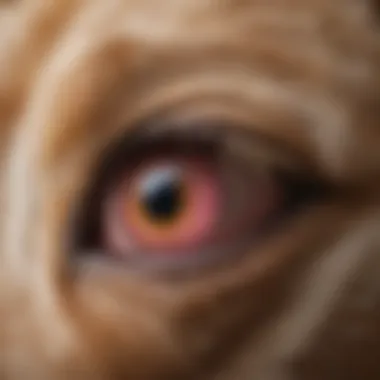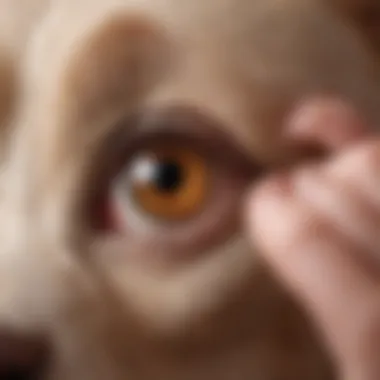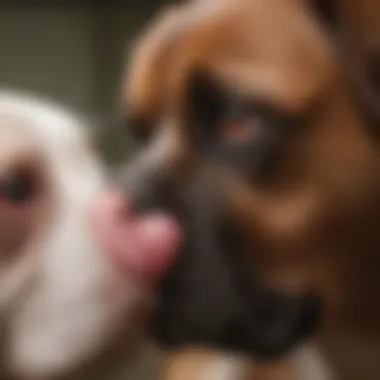Effective Home Remedies for Dog Pink Eye Treatment


Intro
Pink eye, or conjunctivitis, affects many dogs, leading to discomfort and irritation. Understanding how to address this condition at home can be vital for dog owners. This guide explores various aspects of dog pink eye, focusing on home treatment options, preventive measures, and the importance of recognizing when professional veterinary help is needed.
Fascinating Facts About the Animal
Unique Characteristics
Dogs are known for their keen senses and strong loyalty to humans. Their eyesight is not as sharp as that of humans, but their perception of motion is superior. This feature can sometimes mask symptoms of pink eye until they become severe. Owners must be observant of changes, such as excessive blinking or tearing.
Extraordinary Abilities
One remarkable ability of dogs is their capacity to perceive a wide range of colors, although they primarily see in shades of blue and yellow. Such differences in vision often lead to them missing more subtle signs of eye problems like conjunctivitis. Therefore, regular eye checks can be beneficial.
Causes and Symptoms of Pink Eye in Dogs
Conjunctivitis in dogs can stem from various sources. Common causes include allergens like pollen, dust, or certain chemicals. Bacterial or viral infections can also arise from exposure to unsanitary conditions. Some symptoms to be aware of include:
- Red or swollen eyes
- Discharge, either clear or pus-like
- Excessive squinting or blinking
- Pawing at the eyes
To effectively treat pink eye, recognizing these symptoms early is crucial. Dog owners should monitor any changes closely.
Home Treatment Options for Dog Pink Eye
Home remedies can be helpful to alleviate mild cases of conjunctivitis. However, they should be approached with caution, as some conditions might worsen without proper care.
Cleaning the Eye
Using a sterile saline solution can assist in flushing out any debris or irritants. Ensure to use a clean cloth or cotton ball to avoid contamination.
Natural Remedies
- Chamomile tea: A cooled chamomile tea bag can be placed over the eye for a soothing effect.
- Coconut oil: Applying a small amount around the dog’s eye can help with hydration.
When to Seek Veterinary Care
If symptoms do not improve within a day or two, it is crucial to consult a veterinarian. Persistent conjunctivitis might indicate a more severe underlying issue requiring medical intervention.
Important: Any sign of severe swelling, vision loss, or continuous discharge should prompt an immediate call to the vet.
Preventive Measures
Prevention plays a key role in minimizing the likelihood of pink eye in dogs. Some actionable steps include:
- Maintaining cleanliness in the dog's living area.
- Ensuring regular grooming.
- Keeping the dog's eyes away from irritants such as smoke or strong chemicals.
By understanding the causes, symptoms, and treatment of pink eye, dog owners can take proactive measures to ensure their pets remain healthy and comfortable. This knowledge serves not only to treat the condition effectively but also enhances the overall well-being of the dog.
Understanding Dog Pink Eye
Understanding dog pink eye is crucial for pet owners who want to provide the best care for their animals. Pink eye, or conjunctivitis, can lead to discomfort and more severe health issues if not treated properly. This section emphasizes the necessity of recognizing the condition early and comprehending its nuances to intervene efficiently.
Definition and Overview
Dog pink eye is an inflammation of the conjunctiva, the membrane covering the eye and the inside of the eyelids. This condition can arise from various causes, including allergies, infections, or irritants in the environment. Recognizing the definition of pink eye can help owners understand that it is not merely a cosmetic issue but rather a medical one that needs attention.


Pink eye manifests in various forms, leading to a range of symptoms. Owners should be prepared to identify them, as this can facilitate early detection and proper home care. By acknowledging the significance of appropriate knowledge, owners can enhance their dogs' wellbeing while managing any discomfort the condition might present.
Types of Conjunctivitis in Dogs
Allergic Conjunctivitis
Allergic conjunctivitis is a form that occurs when a dog's immune system reacts to allergens. Common irritants include pollen, dust mites, or certain substances in foods. A key characteristic of this type of pink eye is that it often affects both eyes. This type is beneficial for this article because it underscores the importance of identifying allergens for effective management.
Unique features include seasonal variations, where symptoms may intensify during specific seasons due to increased allergens in the environment. The main advantage is that if the allergens are identified and controlled, treating the condition can become simpler. Amidst this, owners must be cautious with treatments; using the wrong remedy may heighten the dog's discomfort.
Bacterial Conjunctivitis
Bacterial conjunctivitis is caused by bacteria invading the eye, resulting in typical symptoms like redness and discharge. A significant aspect of bacterial conjunctivitis is that it may often present with eye discharge that may be yellow or green. This type is popular in this article as it highlights the necessity of distinguishing between potential infections.
A unique feature of bacterial conjunctivitis is that it can transmit from one dog to another. Owners must, therefore, understand that maintaining hygiene is essential. The advantage of recognizing this type is the potential for prompt treatment with antibiotic medications, ensuring swift recovery before the condition worsens.
Viral Conjunctivitis
Viral conjunctivitis is often less common than the other types but can be serious. It usually results from viral infections, such as canine distemper, which could potentially complicate health with systemic symptoms. A key characteristic of viral conjunctivitis is that the discharge may be watery, and it can accompany upper respiratory signs. This form serves the article’s goal by emphasizing the potential severity and systemic connections to other health issues in dogs.
The unique feature here is the length of viral conjunctivitis. It often requires longer observation and care, with treatment alleviating symptoms but not eliminating the virus. Hence, promoting the proper treatment and vigilance is crucial. The challenge with viral conjunctivitis is not treating it directly, but rather supporting the dog while the immune system fights off the infection.
Identifying Symptoms of Pink Eye
Recognizing the symptoms of pink eye in dogs is a critical aspect of effective treatment. Early identification allows for timely intervention, which can mitigate potential complications. Understanding these signs aids pet owners in distinguishing between various types of conjunctivitis and other eye-related issues. By being proactive, you can provide relief to your pet and ensure their well-being.
Common Signs to Recognize
When observing your dog, there are several signs that may indicate pink eye or conjunctivitis. Common symptoms to be aware of include:
- Redness in the eye or eyelids: A primary indicator of inflammation.
- Excessive tearing: This can range from clear fluid to pus-like discharge.
- Squinting or pawing at the eye: Your dog may show discomfort or pain.
- Swelling of the eyelids: Inflammation is a common reaction.
- Behavior changes: These may include increased irritability or withdrawal.
Identifying these signs early can be important in deciding whether home treatment is adequate or if veterinary assistance is necessary.
Specific Symptoms for Each Type
Understanding the specific symptoms associated with each type of conjunctivitis is essential. Each category of pink eye—be it allergic, bacterial, or viral—has its unique signs. This knowledge can help in determining the best course of action for treatment.
Symptoms of Allergic Conjunctivitis
Allergic conjunctivitis often presents with clear, watery discharge and significant itching. Dogs may frequently rub their eyes, leading to redness and swelling around the eyelids. Recognizing this type is essential because it signifies an allergic response, often related to environmental factors like pollen or dust. The humane and non-infectious nature of allergic conjunctivitis allows for effective home treatment options, such as antihistamines or eye washing without urgency for immediate veterinary care.
Symptoms of Bacterial Conjunctivitis
Bacterial conjunctivitis typically involves more severe discharge, often presenting as yellow or green pus. This can produce a sticky residue around the eyes. If your dog shows these signs along with squinting or significant discomfort, it is likely that an infection is present. This condition is contagious and may require antibiotic treatment for effective management. Identifying bacterial conjunctivitis is crucial, as improper treatment can lead to more severe complications.
Symptoms of Viral Conjunctivitis
Viral conjunctivitis often presents similarly to bacterial types but usually follows another viral illness. Symptoms may include redness and watery discharge, though not as severe as bacterial conjunctivitis. A distinguishing feature may be a history of respiratory symptoms. Recognizing this form can lead to appropriate care strategies focusing on support and symptom relief rather than invasive treatments.
Proper diagnosis of conjunctivitis type can lead to effective home care and improved outcomes for your pet.
Causes of Pink Eye in Dogs
Understanding the causes of pink eye, or conjunctivitis, in dogs is essential. This knowledge enables pet owners to take the right steps in preventing and treating the condition. Different factors contribute to pink eye, encompassing both environmental elements and underlying infections or allergies. By recognizing these causes, owners can better identify triggers and implement effective home care strategies. It is important to address these causes for both the immediate comfort of the dog and the long-term health of their eyes.
Environmental Factors


Environmental influences are a significant contributor to the development of pink eye in dogs. Factors such as dust, smoke, pollen, and other allergens can irritate a dog's eyes. Exposure to harsh chemicals, like those found in cleaning products, can also lead to eye irritation.
Owners should consider the environment in which their dog spends most of its time. For instance, if a dog is mostly outdoors, they may come into contact with pollen and dust more regularly. On the other hand, dogs living in homes with smokers may experience increased eye problems due to smoke irritation.
To minimize these environmental causes:
- Keep living spaces clean. Regular cleaning can help remove dust and allergens that accumulate.
- Avoid using strong chemicals. Opt for pet-safe cleaning products whenever possible.
- Limit outdoor exposure during peak pollen seasons. This can help reduce the risk of allergic conjunctivitis.
Infections and Allergies
Infections and allergies are the primary medical causes of pink eye in dogs. Bacterial or viral infections often lead to conjunctivitis, which can spread rapidly. Allergies, meanwhile, may provoke an immune response that results in eye swelling and redness.
Bacterial Conjunctivitis: This can occur when bacteria enter the eye, causing discharge and discomfort. It typically requires veterinary attention for appropriate treatment.
Viral Conjunctivitis: Viruses like canine distemper can lead to conjunctivitis as well. Prevention through vaccination is crucial.
Allergic Conjunctivitis: For dogs sensitive to allergens, exposure can result in red and watery eyes. Antihistamines may be necessary in some cases.
Recognizing the cause of pink eye is essential in determining the best approach for treatment. In cases of infection, early intervention can prevent severe damage. Awareness of potential allergens in a dog’s environment can aid in avoiding recurrence.
Understanding the root causes of pink eye can significantly impact the speed and effectiveness of treatment. Knowing whether the issue arises from environmental factors or infections enhances the ability to respond appropriately.
Home Treatment Options
Home treatment options for dog pink eye are crucial for pet owners seeking to alleviate their dog's discomfort. Understanding the various methods available at home can greatly improve the efficacy of care. By addressing the issue early, owners may reduce the severity of symptoms and enhance their dog's quality of life. However, it is important to remember that not all cases can be managed at home and some require veterinary attention.
Basic Cleaning and Care
Cleaning the Affected Eye Area
Cleaning the affected eye area is the first step in managing dog pink eye. This practice removes debris and discharge that can contribute to irritation. The key characteristic of daily cleaning is its simplicity; using a soft, damp cloth, pet owners can gently wipe the area around the eye. This is a popular choice because it requires minimal resources and can be done consistently.
A unique feature of this method is its effectiveness in preventing further infection. By keeping the area clean, potential irritants are removed, reducing the likelihood of complications. However, care must be taken to avoid excessive rubbing, as this can worsen the irritation.
Using Warm Compresses
Using warm compresses is another beneficial treatment for dog pink eye. This method promotes circulation and can aid in soothing inflammation. The key aspect of warm compresses is their comforting nature, which can significantly ease your dog's discomfort. Many pet owners find this method popular as it provides immediate relief and is easy to implement.
A notable advantage of warm compresses is that they help loosen any crust that may have formed around the eye. Moreover, this practice can encourage drainage of mucus buildup. Still, it is important to ensure that the compress is not too hot, as this can cause burns or further irritation.
Over-the-Counter Remedies
Eye Wash Solutions
Eye wash solutions are an effective option to rinse the eyes and remove irritants. These solutions help flush out foreign particles and reduce discomfort. A key characteristic of eye wash solutions is their ease of use; they come in pre-packaged bottles designed for safe application. This makes them a favorable choice for pet owners seeking quick relief.
The unique feature of eye wash solutions is their ability to support eye hygiene without any harsh chemicals. They often contain gentle ingredients that cleanse effectively. However, while they can provide temporary relief, they are not a substitute for veterinary care if symptoms persist.
Antihistamines
Antihistamines can be useful for allergic conjunctivitis in dogs. They help mitigate symptoms such as itching and redness. A key characteristic of antihistamines is their ability to address allergic reactions quickly. This makes them a beneficial choice for pet owners dealing with seasonal allergies affecting their pets.
One advantage of antihistamines is their relatively quick action to relieve symptoms. Nonetheless, caution is required as some dogs may experience side effects, including drowsiness. Consulting a veterinarian before administering any medication is always advisable to ensure safety and efficiency.
When to Seek Veterinary Assistance
Recognizing when to seek veterinary assistance is crucial for a dog suffering from pink eye. While some instances of conjunctivitis can be treated at home with proper care, certain symptoms could indicate more serious underlying conditions that require professional intervention. Understanding these signs can directly impact the health and comfort of your dog.


Evaluating the symptoms your dog displays can guide your decisions. If home remedies are ineffective or symptoms worsen, taking prompt action is essential. This can prevent further complications and may be vital for your dog’s overall wellness.
Signs Indicating the Need for a Vet
It is important to be observant of the signs that suggest a veterinarian's expertise is needed. Here are key indicators:
- Persistent symptoms: If the pink eye symptoms last more than 48 hours despite home treatment, seek veterinary care.
- Severe swelling: Noticeable puffiness or inflammation of eyelids may point to a more serious issue.
- Excessive discharge: Blood, pus, or any abnormal discharge requires immediate attention.
- Painful behavior: If your dog exhibits signs of pain such as pawing at the eye, squinting, or excessive tearing, it's a warning sign.
- Changes in vision: Any signs that your dog struggles to see should not be ignored.
- Fever or lethargy: These symptoms may indicate a systemic infection and must be examined by a veterinarian.
A quick response is essential for treating serious conditions, ensuring your dog's health and comfort.
Consequences of Delayed Treatment
Delaying veterinary care can have severe consequences for dogs with pink eye. The longer potential issues go unaddressed, the higher the risk of serious complications.
Some possible outcomes include:
- Worsening of the condition: What may initially appear as simple conjunctivitis can evolve into more severe ocular disorders, damaging the eye.
- Spread of infection: If the condition is caused by a bacterial or viral infection, lack of prompt treatment can lead to further spread within the body.
- Chronic issues: Persistent eye problems can become chronic, leading to ongoing discomfort and requiring more complex and expensive treatments.
- Vision loss: Untreated eye issues may result in permanent damage to your dog's eyesight.
In summary, being alert to symptoms and seeking timely veterinary assistance is pivotal for effective treatment. Your dog's eye health depends on it.
Preventive Measures for Eye Health
Maintaining optimal eye health in dogs is vital for their overall well-being and quality of life. Preventive measures play a crucial role in reducing the incidence of pink eye, or conjunctivitis. A proactive approach not only helps in keeping a dog’s eyes healthy but also minimizes the risk of complications. Careful attention to the environment and habits can serve as effective strategies against potential eye issues.
Maintaining a Clean Environment
A clean environment is one of the most effective ways to prevent eye infections, including pink eye. Dust, pollen, and other allergens are common irritants that can lead to inflammation. Regular cleaning can significantly reduce these irritants. Pet owners should consider the following steps:
- Regularly Vacuum and Dust: Keeping living areas free from dust and allergens is essential. Vacuum carpets and clean surfaces regularly.
- Wash Bedding Frequently: Dog beds and blankets should be washed regularly to eliminate possible allergens and bacteria.
- Limit Exposure to Irritants: During allergy seasons, try to keep your dog indoors as much as possible. Avoid areas where allergens are present, such as tall grass or flower gardens.
- Keep Eyes Free from Debris: Regularly check your dog’s eyes for any discharge or debris that may accumulate and clean them gently with a soft, damp cloth.
These practices create a safer environment for your dog, reducing the risk of allergic reactions and bacterial infections.
Regular Veterinary Check-Ups
Routine veterinary check-ups are an important aspect of preventive healthcare for dogs. Regular visits can identify potential health issues before they become severe, including those affecting the eyes. Importance of regular vet visits include:
- Early Detection of Problems: Regular check-ups help in spotting early signs of eye disorders or infections.
- Vaccinations and Treatments: Keeping vaccinations up-to-date is essential. Certain diseases that affect eye health can be prevented through vaccination.
- Professional Cleaning: Vets can provide professional cleaning services for tear stains and other eye-related concerns that owners may lack expertise in.
- Tailored Advice: Each dog’s needs may vary based on breed, age, and health status. A veterinarian can offer specific recommendations to maintain eye health based on these factors.
“An ounce of prevention is worth a pound of cure.”
By integrating these practices into your routine, you can contribute significantly to your canine friend’s well-being.
The End
In summarizing the comprehensive guide on treating dog pink eye at home, it becomes evident that understanding the intricacies of conjunctivitis is crucial for dog owners. As outlined, recognizing symptoms early can lead to better management and a swift return to health. The importance of maintaining a clean environment cannot be overstated. Not only does it aid in recovery, but it also serves as a preventive measure against future occurrences.
Home treatment options, while beneficial, require careful consideration. Owners must be aware of the limits of self-care in managing their pet's health. Knowing when to consult a veterinarian is essential to avoid complications.
Key Takeaway: Active involvement in your dog's eye health is vital.
This guide empowers pet owners with knowledge. It stresses the importance of proper eye hygiene, the use of appropriate over-the-counter remedies, and highlights signs that warrant professional care. Such understanding enriches the bond between pets and their owners, enhancing overall well-being.
Summary of Key Points
- Understanding Symptoms: Early recognition of conjunctivitis symptoms is crucial for effective treatment. Be aware of signs specific to allergic, bacterial, and viral types.
- Home Remedies: Basic cleaning and the application of warm compresses can provide relief. Over-the-counter solutions, such as eye washes and antihistamines, can also be helpful.
- Veterinary Consultation: Always monitor your dog closely. If symptoms worsen or do not improve, seek veterinary advice promptly.
- Preventive Measures: Regularly clean your dog's environment and schedule routine check-ups to maintain optimal eye health.
Final Thoughts on Home Care for Dog Pink Eye
Providing home care for dog pink eye is not a trivial task. It requires vigilance and a good understanding of your pet's needs. The insights gained from this guide can serve as a roadmap, helping pet owners navigate the complexities involved with this condition.
Addressing pink eye early with proper cleaning and care can make a significant difference in your dog’s recovery process. Yet, it is equally important not to overlook symptoms or delays in treatment. Remember: proactive measures and timely veterinary intervention can prevent further issues, ensuring a healthier life for your furry companion.
Educating oneself about this common ailment not only fosters a sense of responsibility but also creates a more profound connection with your pet. Take the time to appreciate the health of your dog's eyes – it can lead to a happier and healthier life for both of you.







